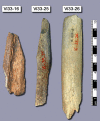NCBI Bookshelf. A service of the National Library of Medicine, National Institutes of Health.
Dean L, McEntyre J, editors. Coffee Break: Tutorials for NCBI Tools [Internet]. Bethesda (MD): National Center for Biotechnology Information (US); 1999-.
Just over 150 years ago, the first fossils of our closest relative, the Neanderthal, were discovered in Germany. From analyzing these bones and comparing them to ours, we have predicted what the Neanderthal might look like, when the Neanderthal emerged, roamed, and eventually went extinct about 30,000 years ago. During their travels, they would have encountered the ancestors of modern day humans. But much controversy has existed on whether there was any interbreeding between Neanderthals and the ancestors of modern humans. Fossils have not given us a definitive answer and the Neanderthal mitochondrial genome suggested no gene mixing had occurred. But now the complete nuclear genome has been sequenced, and it has given us some surprising answers.
Green et al. published the first draft of the Neanderthal genome in May 2010. It is a composite genome, based on ancient DNA samples collected from the bones of three female Neanderthals (figure 1), who lived at different times in a cave in Croatia, about 40,000 years ago (figure 2).

Figure 2
Entrance of the Vindija Cave, Croatia. (Copyright: Johannes Krause, Max Planck Institute for Evolutionary Anthropology)
The team compared the Neanderthal genome to other samples of Neanderthal DNA collected from fossils in Spain, Germany and Russia. This confirmed that their composite genome is a fair representation of the Neanderthal species. They then compared the genome to that of the chimpanzee and to modern human genomes. For this comparison, they also sequenced the genomes of five living humans who originate from different parts of the world: Southern Africa, West Africa, France, Papua New Guinea, and China. These comparisons revealed which parts of the current human genomes have evolved recently, since Neandertals and humans diverged.
To perhaps everyone's surprise, the genome comparisons revealed interbreeding had taken place between Neanderthals and our ancestors, but not as we expected. Despite there being no evidence that Neanderthals lived in China and Papua New Guinea, the two individuals from these areas are as closely related to the Neanderthals as the French individual is. In fact, these three people share 1% to 4% of their nuclear DNA with Neanderthals. In contrast, the comparisons do not show any evidence of interbreeding with the ancestors of Africans. One theory to explain this is that gene mixing took place much earlier than thought, after early humans had migrated out of Africa and into regions such as the Middle East (at least 100,000 years ago) but before they migrated to Europe and western Asia. The genetic contribution from Neandertals would then have been carried with early humans as the colonized all of Eurasia.
The comparisons with modern human genomes also revealed 78 individual genetic changes that result in protein differences between humans and Neanderthals. The number of changes is remarkably small given the 300,000 years which separate humans and Neanderthals from their common ancestor. But these differences do occur in interesting genes.
For example, three out of six genes that had multiple substitutions were in skin, suggesting the importance of skin form and function to the evolution of humans. One of these is the TRPM1 Gene, which code for melastatin, an ion channel important for maintaining melanocyte pigmentation in the skin. The same substitution found in some humans removes the start codon. The RPTN gene encodes repetin, an extracellular epidermal matrix protein found in the epidermis, and at high levels in sweat glands, hair roots, and the tongue.
Other differences are in genes important in cognitive development, and mutations in some of these genes in modern humans lead to a variety of disorders. For example, mutations of DYRK1A contribute to Down syndrome, CADPS2 and AUTS2 to autism, and NRG3 to schizophrenia. Other interesting genes affected include SPAG17, which encodes a protein that is important for the beating of the sperm tail, while RUNX2 is the only gene in the genome known to cause cleidocranial dysplasia. Features of this disease include a bell-shaped rib cage, a protruding frontal bone, and a small or absent collar bone. As Neanderthal rib cage is typically bell-shaped, the frontal bone is prominent, and the collar bone is different in shape to human (figure 3), it is plausible that changes in RUNX2 were important in human evolution.
Such genetic changes are important to our understanding of the most recent evolution of humans. And it also brings us closer to understanding what led to the mysterious extinction of one of our closets relatives.
This Coffee Break was reviewed by Professor Richard E. (Ed) Green.
References
- 1.
- Green Richard E, Krause Johannes, Briggs Adrian W, Maricic Tomislav, Stenzel Udo, Kircher Martin, Patterson Nick, Li Heng, Zhai Weiwei, Fritz Markus Hsi-Yang, Hansen Nancy F, Durand Eric Y, Malaspinas Anna-Sapfo, Jensen Jeffrey D, Marques-Bonet Tomas, Alkan Can, Prüfer Kay, Meyer Matthias, Burbano Hern´n A, Good Jeffrey M, Schultz Rigo, Aximu-Petri Ayinuer, Butthof Anne, Höber Barbara, Höffner Barbara, Siegemund Madlen, Weihmann Antje, Nusbaum Chad, Lander Eric S, Russ Carsten, Novod Nathaniel, Affourtit Jason, Egholm Michael, Verna Christine, Rudan Pavao, Brajkovic Dejana, Kucan Zeljko, Gusic Ivan, Doronichev Vladimir B, Golovanova Liubov V, Lalueza-Fox Carles, de la Rasilla Marco, Fortea Javier, Rosas Antonio, Schmitz Ralf W, Johnson Philip L F, Eichler Evan E, Falush Daniel, Birney Ewan, Mullikin James C, Slatkin Montgomery, Nielsen Rasmus, Kelso Janet, Lachmann Michael, Reich David, Pääbo Svante. A draft sequence of the Neandertal genome. Science. 2010;328:710–722. [PMC free article: PMC5100745] [PubMed: 20448178]
- The evolution of neanderthals and humans
- Decoding the genome of the neanderthal
- Full text articles on the neanderthal from PubMed Central
- View the complete mitochondrial genome in Entrez Genome and the Sequence Viewer.
- And there are over 30 Neanderthal genes in Entrez Gene and over 90 Neanderthal proteins in Entrez Protein.
- Browse the taxonomic tree. The family of apes Hominoidea) includes the gorilla, chimpanzee, humans, and Neanderhals (Homo sapiens neanderthalensis).
- Search all NCBI databases using Entrez.
- Neanderthal man lives on in some of us - Coffee BreakNeanderthal man lives on in some of us - Coffee Break
Your browsing activity is empty.
Activity recording is turned off.
See more...


